TP-Link 1910010885 User Manual
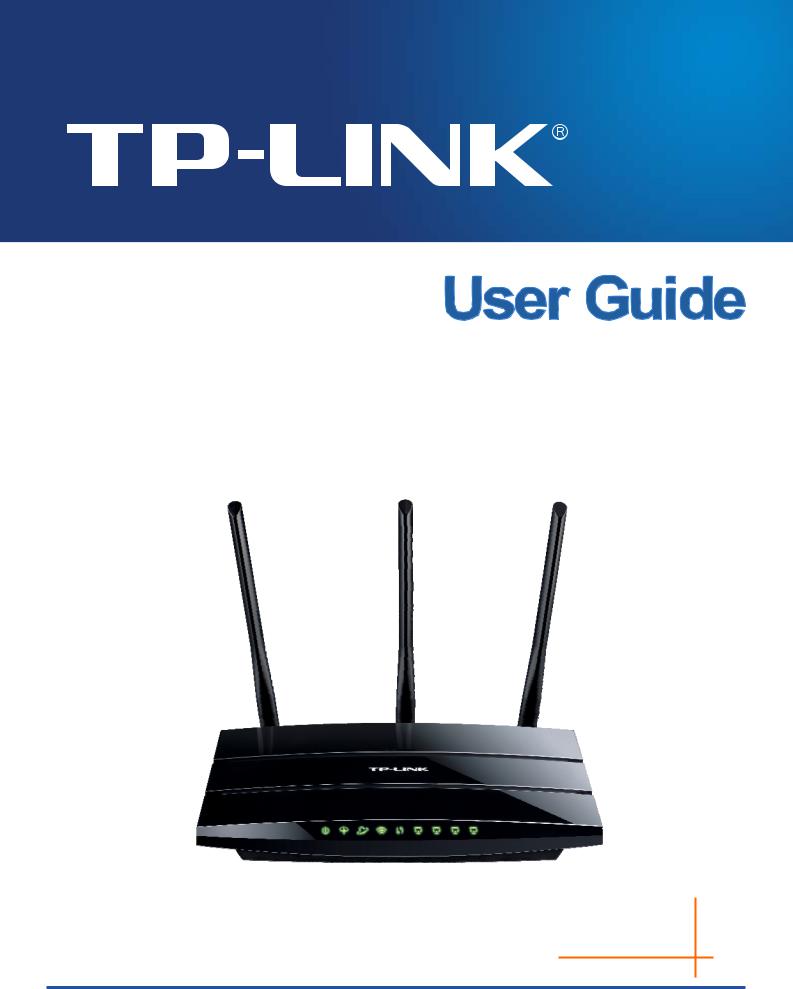
TD-W8970B
300Mbps Wireless N Gigabit ADSL2+ Modem Router (Annex B)
REV: 1.1.0 1910010885
COPYRIGHT & TRADEMARKS
Specifications are subject to change without notice.  is a registered trademark of TP-LINK TECHNOLOGIES CO., LTD. Other brands and product names are trademarks or registered trademarks of their respective holders.
is a registered trademark of TP-LINK TECHNOLOGIES CO., LTD. Other brands and product names are trademarks or registered trademarks of their respective holders.
No part of the specifications may be reproduced in any form or by any means or used to make any derivative such as translation, transformation, or adaptation without permission from TP-LINK TECHNOLOGIES CO., LTD. Copyright © 2013 TP-LINK TECHNOLOGIES CO., LTD. All rights reserved.
http://www.tp-link.com

FCC STATEMENT
This equipment has been tested and found to comply with the limits for a Class B digital device, pursuant to part 15 of the FCC Rules. These limits are designed to provide reasonable protection against harmful interference in a residential installation. This equipment generates, uses and can radiate radio frequency energy and, if not installed and used in accordance with the instructions, may cause harmful interference to radio communications. However, there is no guarantee that interference will not occur in a particular installation. If this equipment does cause harmful interference to radio or television reception, which can be determined by turning the equipment off and on, the user is encouraged to try to correct the interference by one or more of the following measures:
•Reorient or relocate the receiving antenna.
•Increase the separation between the equipment and receiver.
•Connect the equipment into an outlet on a circuit different from that to which the receiver is connected.
•Consult the dealer or an experienced radio/ TV technician for help.
This device complies with part 15 of the FCC Rules. Operation is subject to the following two conditions:
1)This device may not cause harmful interference.
2)This device must accept any interference received, including interference that may cause undesired operation.
Any changes or modifications not expressly approved by the party responsible for compliance could void the user’s authority to operate the equipment.
Note: The manufacturer is not responsible for any radio or tv interference caused by unauthorized modifications to this equipment. Such modifications could void the user’s authority to operate the equipment.
FCC RF Radiation Exposure Statement
This equipment complies with FCC RF radiation exposure limits set forth for an uncontrolled environment. This device and its antenna must not be co-located or operating in conjunction with any other antenna or transmitter.
“To comply with FCC RF exposure compliance requirements, this grant is applicable to only Mobile Configurations. The antennas used for this transmitter must be installed to provide a separation distance of at least 20 cm from all persons and must not be co-located or operating in conjunction with any other antenna or transmitter.”
CE Mark Warning
This is a class B product. In a domestic environment, this product may cause radio interference, in which case the user may be required to take adequate measures.
Canadian Compliance Statement
This device complies with Industry Canada license-exempt RSS standard(s). Operation is subject to the following two conditions:
(1)This device may not cause interference, and
(2)This device must accept any interference, including interference that may cause undesired operation of the device.
Cet appareil est conforme aux norms CNR exemptes de licence d’Industrie Canada. Le fonctionnement est soumis aux deux conditions suivantes:
(1)cet appareil ne doit pas provoquer d’interférences et
(2)cet appareil doit accepter toute interférence, y compris celles susceptibles de provoquer un fonctionnement non souhaité de l’appareil.
This device has been designed to operate with the antennas listed below, and having a maximum gain of 5dBi. Antennas not included in this list or having a gain greater than 5dBi are strictly prohibited for use with this device. The required antenna impedance is 50 ohms.
To reduce potential radio interference to other users, the antenna type and its gain should be so chosen that the equivalent isotropically radiated power (e.i.r.p.) is not more than that permitted for successful communication.
Industry Canada Statement
Complies with the Canadian ICES-003 Class B specifications.
Cet appareil numérique de la classe B est conforme à la norme NMB-003 du Canada.
This device complies with RSS 210 of Industry Canada. This Class B device meets all the requirements of the Canadian interference-causing equipment regulations.
Cet appareil numérique de la Classe B respecte toutes les exigences du Règlement sur le matériel brouilleur du Canada.
Korea Warning Statements:
.
NCC Notice & BSMI Notice
加大功率或變更原設計之特性或功能。
頻電機需忍受合法通信或工業、科學以及醫療用電波輻射性電機設備之干擾。

Продукт сертифіковано згідно с правилами системи УкрСЕПРО на відповідність вимогам нормативних документів та вимогам, що передбачені чинними законодавчими актами України.
Safety Information
zWhen product has power button, the power button is one of the way to shut off the product; when there is no power button, the only way to completely shut off power is to disconnect the product or the power adapter from the power source.
zDon’t disassemble the product, or make repairs yourself. You run the risk of electric shock and voiding the limited warranty. If you need service, please contact us.
zAvoid water and wet locations.
This product can be used in the following countries:
AT |
BG |
BY |
CA |
CZ |
DE |
DK |
EE |
|
|
|
|
|
|
|
|
ES |
FI |
FR |
GB |
GR |
HU |
IE |
IT |
|
|
|
|
|
|
|
|
LT |
LV |
MT |
NL |
NO |
PL |
PT |
RO |
|
|
|
|
|
|
|
|
RU |
SE |
SK |
TR |
UA |
|
|
|
|
|
|
|
|
|
|
|

TP-LINK TECHNOLOGIES CO., LTD
DECLARATION OF CONFORMITY
For the following equipment:
Product Description: 300Mbps Wireless N Gigabit ADSL2+ Modem Router (Annex B)
Model No.: TD-W8970B
Trademark: TP-LINK
We declare under our own responsibility that the above products satisfy all the technical regulations applicable to the product within the scope of Council Directives:
Directives 1999/5/EC, Directives 2004/108/EC, Directives 2006/95/EC, Directives 1999/519/EC, Directives 2011/65/EU
The above product is in conformity with the following standards or other normative documents
ETSI EN 300 328 V1.7.1: 2006
ETSI EN 301 489-1 V1.9.2:2011& ETSI EN 301 489-17 V2.2.1:2012
EN 55022:2010
EN 55024:2010
EN 61000-3-2:2006+A1:2009+A2:2009
EN 61000-3-3:2008
EN60950-1:2006+A11 2009+A1:2010+A12:2011
EN62311:2008
The product carries the CE Mark:
Person responsible for marking this declaration:
Yang Hongliang
Product Manager of International Business
Date of issue: 2013
TP-LINK TECHNOLOGIES CO., LTD
Building 24 (floors 1, 3, 4, 5), and 28 (floors 1-4) Central Science and Technology Park,
Shennan Rd, Nanshan, Shenzhen, China
|
CONTENTS |
|
Package Contents .................................................................................................... |
1 |
|
Chapter 1. Product Overview................................................................................... |
2 |
|
1.1 |
Overview of the Modem Router ...................................................................................... |
2 |
1.2 |
Main Features................................................................................................................. |
3 |
1.3 |
Panel Layout................................................................................................................... |
4 |
|
1.3.1 The Front Panel ................................................................................................................... |
4 |
|
1.3.2 The Back Panel.................................................................................................................... |
6 |
Chapter 2. Connecting the Modem Router ............................................................. |
7 |
|
2.1 |
System Requirements .................................................................................................... |
7 |
2.2 |
Installation Environment Requirements .......................................................................... |
7 |
2.3 |
Connecting the Modem Router....................................................................................... |
8 |
Chapter 3. Quick Installation Guide ........................................................................ |
9 |
|
3.1 |
Configuring the PC ......................................................................................................... |
9 |
3.2 |
Quick Installation Guide................................................................................................ |
12 |
Chapter 4. Configuring the Modem Router .......................................................... |
16 |
|
4.1 |
Login ............................................................................................................................. |
16 |
4.2 |
Status............................................................................................................................ |
16 |
4.3 |
Quick Setup .................................................................................................................. |
17 |
4.4 |
Operation Mode ............................................................................................................ |
18 |
4.5 |
Network......................................................................................................................... |
18 |
|
4.5.1 WAN Settings..................................................................................................................... |
19 |
|
4.5.2 3G Settings ........................................................................................................................ |
29 |
|
4.5.3 Interface Grouping ............................................................................................................. |
32 |
|
4.5.4 LAN Settings ...................................................................................................................... |
33 |
|
4.5.5 IPv6 LAN Settings.............................................................................................................. |
34 |
|
4.5.6 MAC Clone......................................................................................................................... |
35 |
|
4.5.7 ALG Settings...................................................................................................................... |
36 |
|
4.5.8 DSL Settings ...................................................................................................................... |
37 |
|
4.5.9 IPSec VPN ......................................................................................................................... |
37 |
4.6 |
DHCP Server ................................................................................................................ |
40 |
|
4.6.1 DHCP Settings................................................................................................................... |
41 |
|
4.6.2 |
Clients List.......................................................................................................................... |
42 |
|
4.6.3 Address Reservation.......................................................................................................... |
43 |
|
|
4.6.4 |
Conditional Pool................................................................................................................. |
44 |
4.7 |
Wireless ........................................................................................................................ |
45 |
|
|
4.7.1 |
Basic Settings .................................................................................................................... |
45 |
|
4.7.2 WPS Settings..................................................................................................................... |
47 |
|
|
4.7.3 |
Wireless Security ............................................................................................................... |
49 |
|
4.7.4 |
Wireless MAC Filtering ...................................................................................................... |
51 |
|
4.7.5 Wireless Advanced ............................................................................................................ |
53 |
|
|
4.7.6 |
Wireless Status .................................................................................................................. |
54 |
4.8 |
USB Settings ................................................................................................................ |
54 |
|
|
4.8.1 USB Mass Storage ............................................................................................................ |
55 |
|
|
4.8.2 User Accounts.................................................................................................................... |
55 |
|
|
4.8.3 Storage Sharing ................................................................................................................. |
56 |
|
|
4.8.4 FTP Server......................................................................................................................... |
58 |
|
|
4.8.5 Media Server...................................................................................................................... |
60 |
|
|
4.8.6 |
Print Server ........................................................................................................................ |
61 |
4.9 |
Route Settings .............................................................................................................. |
62 |
|
|
4.9.1 Default Gateway................................................................................................................. |
62 |
|
|
4.9.2 |
Static Route........................................................................................................................ |
62 |
|
4.9.3 |
IPv6 Static Route ............................................................................................................... |
63 |
|
4.9.4 |
RIP Settings ....................................................................................................................... |
64 |
4.10 |
Forwarding.................................................................................................................... |
65 |
|
|
4.10.1 Virtual Servers .................................................................................................................. |
65 |
|
|
4.10.2 Port Triggering.................................................................................................................. |
67 |
|
|
4.10.3 DMZ .................................................................................................................................. |
68 |
|
|
4.10.4 UPnP ................................................................................................................................ |
69 |
|
4.11 |
Parental Control............................................................................................................ |
70 |
|
4.12 |
Firewall ......................................................................................................................... |
71 |
|
|
4.12.1 Rule .................................................................................................................................. |
71 |
|
|
4.12.2 LAN Host .......................................................................................................................... |
72 |
|
|
4.12.3 WAN Host ......................................................................................................................... |
73 |
|
|
4.12.4 Schedule........................................................................................................................... |
75 |
|
4.13 |
IPv6 Firewall ................................................................................................................. |
76 |
|
|
4.13.1 IPv6 Rule .......................................................................................................................... |
76 |
|
|
4.13.2 IPv6 LAN Host .................................................................................................................. |
77 |
|
|
4.13.3 IPv6 WAN Host................................................................................................................. |
78 |
|
4.13.4 IPv6 Schedule................................................................................................................... |
79 |
4.14 |
IPv6 Tunnel................................................................................................................... |
80 |
4.15 |
Bandwidth Control ........................................................................................................ |
82 |
4.16 |
IP&MAC Binding ........................................................................................................... |
84 |
|
4.16.1 Binding Settings................................................................................................................ |
84 |
|
4.16.2 ARP List............................................................................................................................ |
85 |
4.17 |
Dynamic DNS ............................................................................................................... |
86 |
4.18 |
Diagnostic ..................................................................................................................... |
86 |
4.19 |
System Tools ................................................................................................................ |
87 |
|
4.19.1 System Log....................................................................................................................... |
87 |
|
4.19.2 Time Settings.................................................................................................................... |
88 |
|
4.19.3 Manage Control ................................................................................................................ |
89 |
|
4.19.4 CWMP Settings ................................................................................................................ |
90 |
|
4.19.5 SNMP Settings ................................................................................................................. |
91 |
|
4.19.6 Backup & Restore............................................................................................................. |
92 |
|
4.19.7 Factory Defaults................................................................................................................ |
92 |
|
4.19.8 Firmware Upgrade............................................................................................................ |
93 |
|
4.19.9 Reboot .............................................................................................................................. |
94 |
|
4.19.10 Statistics........................................................................................................................ |
94 |
4.20 |
Logout........................................................................................................................... |
96 |
Appendix A: Specifications ................................................................................... |
97 |
|
Appendix B: Troubleshooting ............................................................................... |
98 |
|
Appendix C: Technical Support .......................................................................... |
101 |
|

TD-W8970B 300Mbps Wireless N Gigabit ADSL2+ Modem Router (Annex B) User Guide
Package Contents
The following contents should be found in your package:
¾One TD-W8970B 300Mbps Wireless N Gigabit ADSL2+ Modem Router (Annex B)
¾One Power Adapter for TD-W8970B 300Mbps Wireless N Gigabit ADSL2+ Modem Router (Annex B)
¾Quick Installation Guide
¾One RJ45 cable
¾Two RJ11 cables
¾One ADSL splitter
¾One Resource CD for TD-W8970B 300Mbps Wireless N Gigabit ADSL2+ Modem Router (Annex B), including:
•This User Guide
•Other Helpful Information
) Note:
Make sure that the package contains the above items. If any of the listed items are damaged or missing, please contact your distributor.
1

TD-W8970B 300Mbps Wireless N Gigabit ADSL2+ Modem Router (Annex B) User Guide
Chapter 1. Product Overview
Thank you for choosing the TD-W8970B 300Mbps Wireless N Gigabit ADSL2+ Modem Router
(Annex B).
1.1 Overview of the Modem Router
The TD-W8970B 300Mbps Wireless N Gigabit ADSL2+ Modem Router (Annex B) integrates 4-port Switch, Firewall, NAT-Router and Wireless AP. Powered by 3X3 MIMO technology, the Wireless N Router delivers exceptional range and speed, which can fully meet the need of Small Office/Home Office (SOHO) networks and the users demanding higher networking performance.
The TD-W8970B 300Mbps Wireless N Gigabit ADSL2+ Modem Router (Annex B) utilizes integrated ADSL2+ transceiver and high speed MIPS CPU. The Router supports full-rate ADSL2+ connectivity conforming to the ITU and ANSI specifications.
In addition to the basic DMT physical layer functions, the ADSL2+ PHY supports dual latency ADSL2+ framing (fast and interleaved) and the I.432 ATM Physical Layer.
The router provides up to 300Mbps wireless connection with other 802.11n wireless clients. The incredible speed makes it ideal for handling multiple data streams at the same time, which ensures your network stable and smooth. The performance of this 802.11n wireless Router will give you the unexpected networking experience at speed 650% faster than 802.11g. It is also compatible with all IEEE 802.11g and IEEE 802.11b products.
With multiple protection measures, including SSID broadcast control and wireless LAN 64/128 WEP encryption, Wi-Fi protected Access (WPA2-PSK, WPA-PSK), as well as advanced Firewall protections, the TD-W8970B 300Mbps Wireless N Gigabit ADSL2+ Modem Router (Annex B) provides complete data privacy.
The Router provides flexible access control, so that parents or network administrators can establish restricted access policies for children or staff. It also supports Virtual Server and DMZ host for Port Triggering, and then the network administrators can manage and monitor the network in real time with the remote management function.
Since the Router is compatible with virtually all the major operating systems, it is very easy to manage. Quick Setup Wizard is supported and detailed instructions are provided step by step in this user guide. Before installing the Router, please look through this guide to know all the Router’s functions.
2

TD-W8970B 300Mbps Wireless N Gigabit ADSL2+ Modem Router (Annex B) User Guide
1.2 Main Features
¾Maximum wireless speed up to 300Mbps at 2.4GHz.
¾Four 10/100/1000Mbps Auto-Negotiation RJ45 LAN ports (Auto MDI/MDIX), one RJ11 port.
¾Provides external splitter.
¾Adopts Advanced DMT modulation and demodulation technology.
¾Supports bridge mode and Router function.
¾Multi-user sharing a high-speed Internet connection.
¾Downstream data rates up to 24Mbps, upstream data rates up to 1Mbps.
¾Supports long transfers, the max line length can reach to 6.5Km.
¾Supports remote configuration and management through SNMP and CWMP.
¾Supports PPPoE, it allows connecting the internet on demand and disconnecting from the Internet when idle.
¾Provides reliable ESD and surge-protect function with quick response semi-conductive surge protection circuit.
¾High speed and asymmetrical data transmit mode, provides safe and exclusive bandwidth.
¾Supports All ADSL industrial standards.
¾Compatible with all mainstreams DSLAM (CO).
¾Provides integrated access of internet and route function which face to SOHO user.
¾Real-time Configuration and device monitoring.
¾Supports Multiple PVC (Permanent Virtual Circuit).
¾Built-in DHCP server.
¾Built-in firewall, supporting IP/MAC filter and URL filter.
¾Supports Virtual Server, DMZ host and Port Triggering.
¾Supports Dynamic DNS, UPnP and Static Routing.
¾Supports system log and flow Statistics.
¾Supports firmware upgrade and Web management.
¾Provides WPA-PSK/WPA2-PSK data security, TKIP/AES encryption security.
¾Provides 64/128-bit WEP encryption security and wireless LAN ACL (Access Control List).
¾Supports 3G/3.75G USB Modem Sharing, USB Storage Sharing, Print Server, FTP Server, Media Server.
¾Supports Ethernet WAN (EWAN).
¾Supports Bandwidth Control.
¾Supports IPv6
3

TD-W8970B 300Mbps Wireless N Gigabit ADSL2+ Modem Router (Annex B) User Guide
1.3 Panel Layout
1.3.1 The Front Panel
Figure 1-1
The modem router’s LEDs are located on the front panel (View from left to right). They indicate the device’s working status. For details, please refer to LED Explanation.
LED Explanation:
Name |
Status |
Indication |
|
|
On |
The modem router is powered on. |
|
(Power) |
Off |
The modem router is off. Please ensure that the power adapter is |
|
|
connected correctly. |
||
|
|
||
|
On |
ADSL line is synchronized and ready to use. |
|
(ADSL) |
Flash |
The ADSL negotiation is in progress. |
|
|
ADSL synchronization fails. Please refer to Note 1 for |
||
|
Off |
||
|
troubleshooting. |
||
|
|
||
|
On |
The network is available with a successful Internet connection. |
|
|
Flash |
There is data being transmitted or received via the Internet. |
|
(Internet) |
|
There is no successful Internet connection or the modem router |
|
|
|
||
|
Off |
is operating in Bridge mode. Please refer to Note 2 for |
|
|
|
troubleshooting. |
|
(WLAN) |
Flash |
Wireless is enabled. |
|
Off |
Wireless is disabled. |
||
|
4

TD-W8970B 300Mbps Wireless N Gigabit ADSL2+ Modem Router (Annex B) User Guide
|
|
|
|
|
|
|
|
|
|
|
On |
A wireless device has been successfully added to the network by |
|
|
|
|
|
|
|
|
|
|
|
WPS function. |
|
|
|
|
|
|
|
|
|
|
|
|
|
|
|
|
|
|
|
|
|
|
|
|
|
|
|
|
|
|
|
|
|
|
|
|
|
|
|
WPS handshaking is in process and will continue for about 2 |
|
|
|
|
|
|
|
|
|
|
(WPS) |
Slow Flash |
minutes. Please press the WPS button on other wireless devices |
|
|
|
|
|
|
|
|
|
|
|
that you want to add to the network while the LED is flashing. |
|
|
|
|
|
|
|
|
|
|
|
|
|
|
|
|
|
|
|
|
|
|
|
|
|
|
|
|
|
|
|
|
|
|
|
|
|
|
Quick |
A wireless device has failed to be added to the network by WPS |
|
|
|
|
|
|
|
|
|
|
|
function. Please refer to 4.7.2 WPS Settings for more |
|
|
|
|
|
|
|
|
|
|
|
|
Flash |
|
|
|
|
|
|
|
|
|
|
|
|
information. |
|
|
|
|
|
|
|
|
|
|
|
|
|
|
|
|
|
|
|
|
|
|
|
|
|
|
|
|
|
|
|
|
|
|
|
|
|
|
On |
There is a device connected to this LAN port. |
|
|
|
|
|
|
|
|
|
|
|
|
|
|
|
|
|
|
|
|
|
|
|
(LAN1-4) |
Flash |
The modem router is sending or receiving data over this LAN |
|
|
|
|
|
|
|
|
|
|
port. |
||
|
|
|
|
|
|
|||||||
|
|
|
|
|
|
|
|
|
|
|
|
|
|
|
|
|
|
|
|
|
|
|
|
|
|
|
|
|
|
|
|
|
|
|
|
|
Off |
There is no device connected to this LAN port. |
|
|
|
|
|
||||||||
|
|
(USB on the |
Off |
No storage device or printer is plugged into the USB port. |
||||||||
back panel) |
On |
A storage device or printer has connected to the USB port. |
||||||||||
|
|
|
|
|
|
|
|
|
|
|
||
|
|
|
|
|
|
|
|
|
|
|
|
|
) Note:
1.If the ADSL LED is off, please check your Internet connection first. Refer to 2.3 Connecting the Modem Router for more information about how to make Internet connection correctly. If you have already made a right connection, please contact your ISP to make sure if your Internet service is available now.
2.If the Internet LED is off, please check your ADSL LED first. If your ADSL LED is also off, please refer to Note 1. If your ADSL LED is GREEN ON, please check your Internet configuration. You may need to check this part of information with your ISP and make sure everything have been input correctly.
5
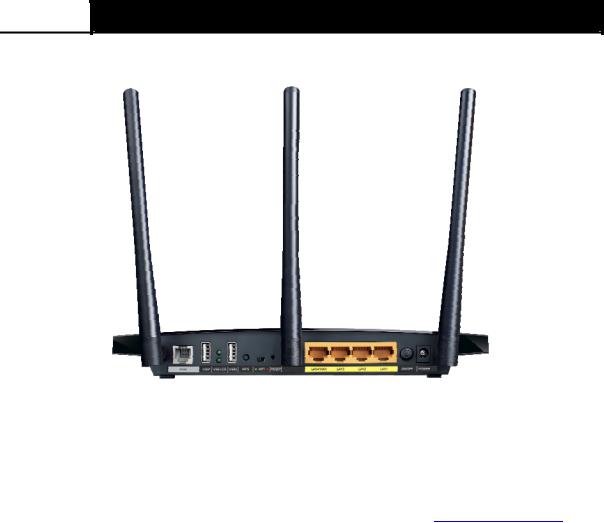
TD-W8970B 300Mbps Wireless N Gigabit ADSL2+ Modem Router (Annex B) User Guide
1.3.2 The Back Panel
Figure 1-2
¾ADSL: Through the port, you can connect the modem router with the telephone. Or you can connect them by an external separate splitter. For details, please refer to 2.3 Connecting the Modem Router.
¾USB1, USB2: The USB port connects to a USB storage device or a USB printer.
¾WPS: The switch for the WPS function. For details, please refer to 4.7.2 WPS Settings.
¾WiFi: The switch for the WiFi function. Move it to left /right to enable/disable the WiFi function.
¾RESET: There are two ways to reset the modem router's factory defaults.
Method one: With the modem router powered on, use a pin to press and hold the Reset button for at least 5 seconds. And the Router will reboot to its factory default settings.
Method two: Restore the default setting from “Maintenance-SysRestart” of the modem router's Web-based Utility.
¾LAN4/WAN, LAN3, LAN2, LAN1: Through these ports, you can connect the modem router to your PC or the other Ethernet network devices. Enable EWAN function and you will be able to connect to Cable/FTTH/VDSL/ADSL device.
¾ON/OFF: The switch for the power.
¾POWER: The Power plug is where you will connect the power adapter.
¾Antennas: Used for wireless operation and data transmit.
6

TD-W8970B 300Mbps Wireless N Gigabit ADSL2+ Modem Router (Annex B) User Guide
Chapter 2. Connecting the Modem Router
2.1 System Requirements
¾ Broadband Internet Access Service (DSL/Cable/Ethernet).
¾ PCs with a working Ethernet Adapter and an Ethernet cable with RJ45 connectors.
¾ TCP/IP protocol on each PC.
¾ Web browser, such as Microsoft Internet Explorer, Mozilla Firefox or Apple Safari.
2.2 Installation Environment Requirements
¾The Product should not be located where it will be exposed to moisture or excessive heat.
¾Place the Router in a location where it can be connected to the various devices as well as to a power source.
¾Make sure the cables and power cord are safely placed out of the way so they do not create a tripping hazard.
¾The Router can be placed on a shelf or desktop.
¾Keep away from the strong electromagnetic radiation and the device of electromagnetic sensitive.
Figure 2-1
7
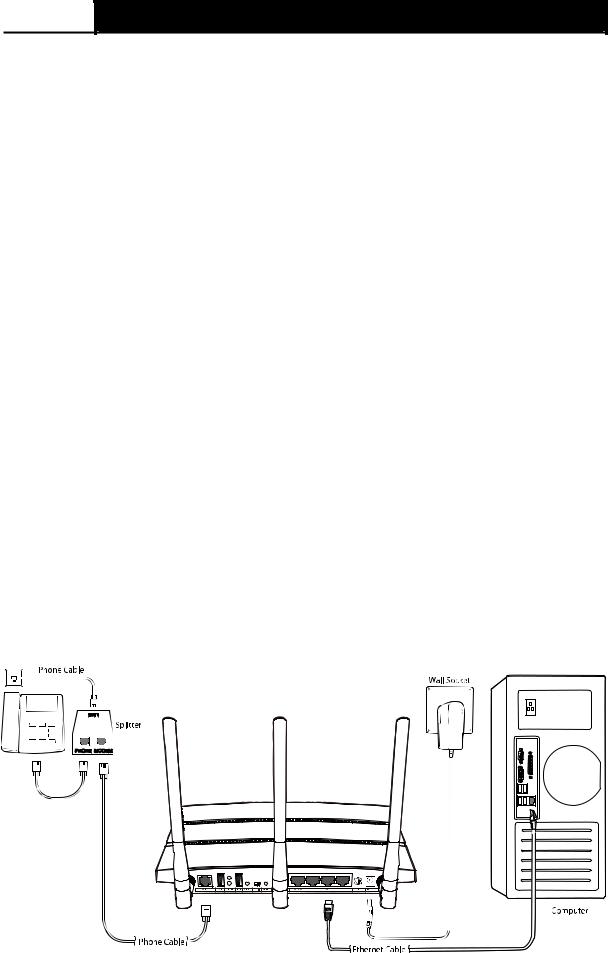
TD-W8970B 300Mbps Wireless N Gigabit ADSL2+ Modem Router (Annex B) User Guide
) Note:
The diameter of the screw, 3.5mm<D<8mm, and the distance of two screws is 122mm. The screw that project from the wall need around 4mm based, and the length of the screw need to be at least 20mm to withstand the weight of the product.
2.3 Connecting the Modem Router
Before installing the device, please make sure your broadband service provided by your ISP is available. If there is any problem, please contact your ISP. Before cable connection, cut off the power supply and keep your hands dry. You can follow the steps below to install it.
Step 1: Connect the ADSL Line.
Method one: Plug one end of the twisted-pair ADSL cable into the ADSL port on the rear panel of TD-W8970B, and insert the other end into the wall socket.
Method two You can use a separate splitter. External splitter can divide the data and voice, and then you can access the Internet and make calls at the same time. The external splitter has three ports:
•LINE: Connect to the wall jack
•PHONE: Connect to the phone sets
•MODEM: Connect to the ADSL port of TD-W8970B
Plug one end of the twisted-pair ADSL cable into the ADSL port on the rear panel of TD-W8970B. Connect the other end to the MODEM port of the external splitter.
Step 2: Connect the Ethernet cable. Attach one end of a network cable to your computer’s Ethernet port or a regular hub/switch port, and the other end to the LAN port on the modem routerTD-W8970B.
Step 3: Power on the computers and LAN devices.
Step 4: Attach the power adapter. Connect the power adapter to the power connector on the rear of the device and plug in the adapter to an electrical outlet or power extension. The electrical outlet shall be installed near the device and shall be easily accessible.
Figure 2-2
8
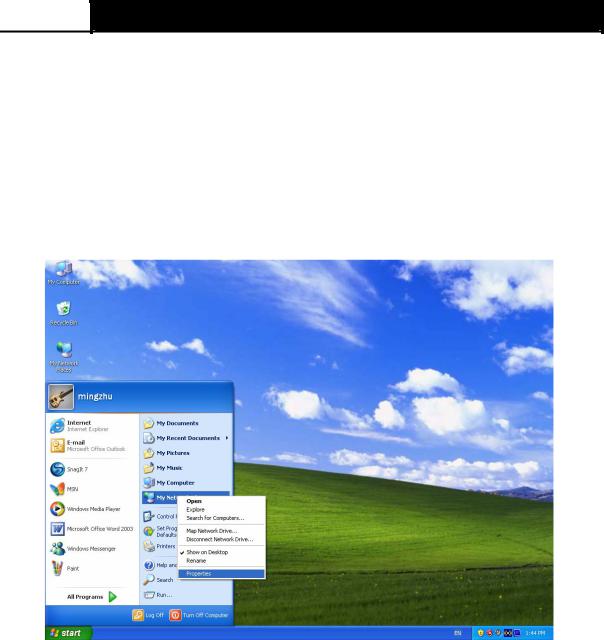
TD-W8970B 300Mbps Wireless N Gigabit ADSL2+ Modem Router (Annex B) User Guide
Chapter 3. Quick Installation Guide
3.1 Configuring the PC
After you directly connect your PC to the modem router TD-W8970B or connect your adapter to a Hub/Switch which has connected to the modem router, you need to configure your PC’s IP address. Follow the steps below to configure it.
Step 1: Click the Start menu on your desktop, right click My Network Places, and then select Properties (shown in Figure 3-1).
Figure 3-1
Step 2: Right click Local Area Connection (LAN), and then select Properties.
9

TD-W8970B 300Mbps Wireless N Gigabit ADSL2+ Modem Router (Annex B) User Guide
Figure 3-2
Step 3: Select General tab, highlight Internet Protocol (TCP/IP), and then click the Properties button.
Figure 3-3
Step 4: Configure the IP address as Figure 3-4 shows. After that, click OK.
10
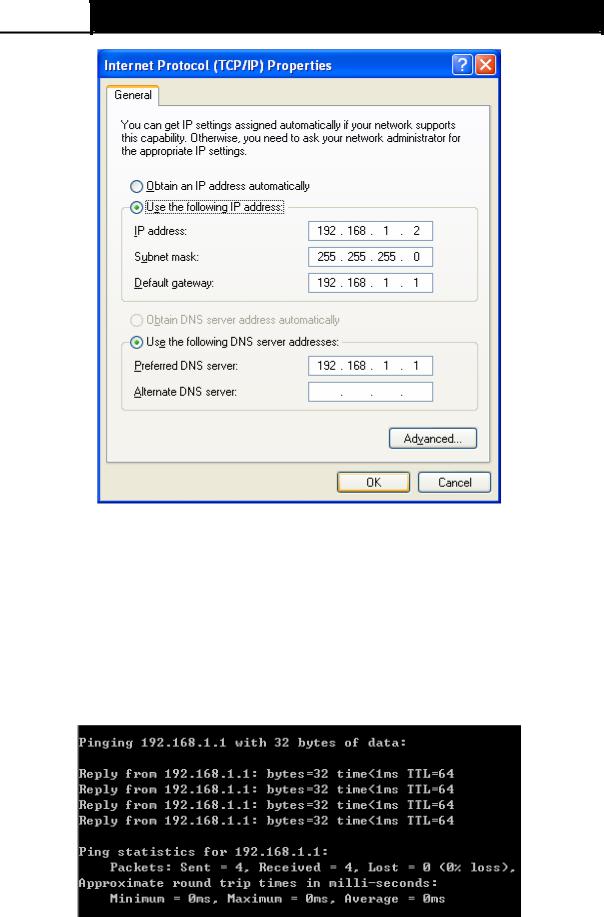
TD-W8970B 300Mbps Wireless N Gigabit ADSL2+ Modem Router (Annex B) User Guide
Figure 3-4
) Note:
You can configure the PC to get an IP address automatically, select “Obtain an IP address automatically” and “Obtain DNS server address automatically” in the screen above.
Now, you can run the Ping command in the command prompt to verify the network connection. Please click the Start menu on your desktop, select run tab, type cmd or command in the field and press Enter. Type ping 192.168.1.1 on the next screen, and then press Enter.
If the result displayed is similar to the screen below, the connection between your PC and the modem router has been established.
Figure 3-5
11
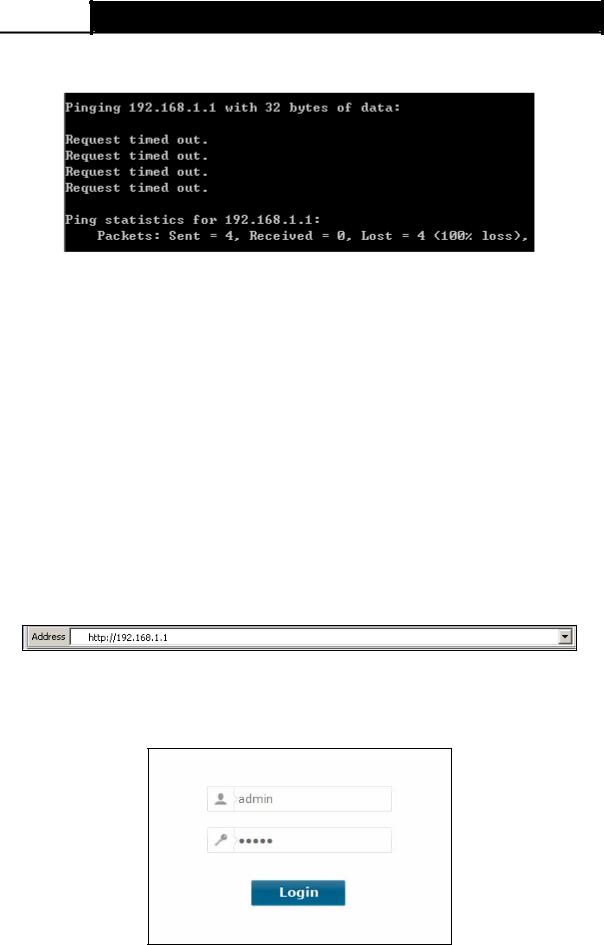
TD-W8970B 300Mbps Wireless N Gigabit ADSL2+ Modem Router (Annex B) User Guide
If the result displayed is similar to the screen shown below, it means that your PC has not connected to the modem router.
Figure 3-6
You can check it following the steps below:
1)Is the connection between your PC and the modem router correct?
The LEDs of LAN port which you link to the device and the LEDs on your PC's adapter should be lit.
2)Is the TCP/IP configuration for your PC correct?
If the Router's IP address is 192.168.1.1, your PC's IP address must be within the range of 192.168.1.2 ~ 192.168.1.254.
3.2 Quick Installation Guide
With a Web-based utility, it is easy to configure and manage the TD-W8970B 300Mbps Wireless N Gigabit ADSL2+ Modem Router (Annex B). The Web-based utility can be used on any Windows, Macintosh or UNIX OS with a Web browser, such as Microsoft Internet Explorer, Mozilla Firefox or Apple Safari.
1.To access the configuration utility, open a web-browser and type the default address http://192.168.1.1 in the address field of the browser.
Figure 3-7
After a moment, a login window will appear, similar to the Figure 3-8. Enter admin for the User Name and Password, both in lower case letters. Then click the Login button or press the
Enter key.
Figure 3-8
12

TD-W8970B 300Mbps Wireless N Gigabit ADSL2+ Modem Router (Annex B) User Guide
) Note:
1)Do not mix up the user name and password with your ADSL account user name and password which are needed for PPP connections.
2)The login screen will be locked for 10 minutes after five failed attempts to login.
3)If the above screen does not pop up, it means that your Web-browser has been set to a proxy. Go to Tools menu→Internet Options→Connections→LAN Settings, in the screen that appears, cancel the Using Proxy checkbox, and click OK to finish it.
2.After your successful login, you will see the Login screen as shown in Figure 3-9. Click Quick Setup menu to access Quick Setup Wizard and then click Next.
Figure 3-9
3.Change the VPI/VCI values which are used to define a unique path for your connection. If you have been given specific settings for this to configuration, type in the correct values assigned by your ISP. Click Next.
Figure 3-10
4.Please select the Connection Type given by your ISP. Here we use PPPoE as an example. Click
Next.
13
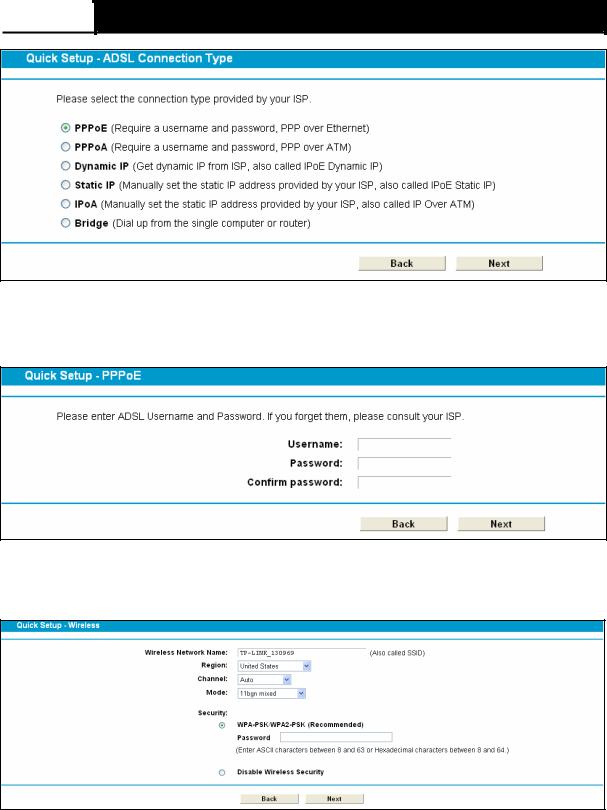
TD-W8970B 300Mbps Wireless N Gigabit ADSL2+ Modem Router (Annex B) User Guide
Figure 3-11
5.Enter the Username, Password and Confirm Password given by your ISP, and then click
Next.
Figure 3-12
6.On the Wireless screen, we use the default SSID, select a Mode. Set a Password or select Disable Security(Disable Security is not recommended.), and then click Next to continue.
Figure 3-13
7.On this page, please confirm all parameters. Click Back to modify or click the Save button to save your configuration.
14
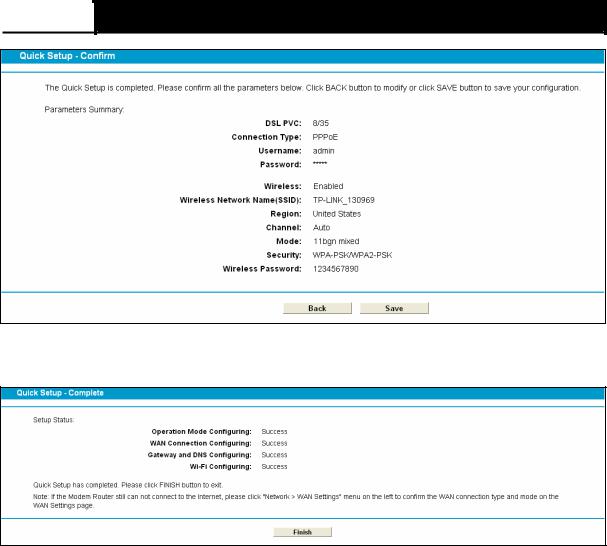
TD-W8970B 300Mbps Wireless N Gigabit ADSL2+ Modem Router (Annex B) User Guide
Figure 3-14
8.You will see the Complete screen below, click Finish to complete these settings.
Figure 3-15
15
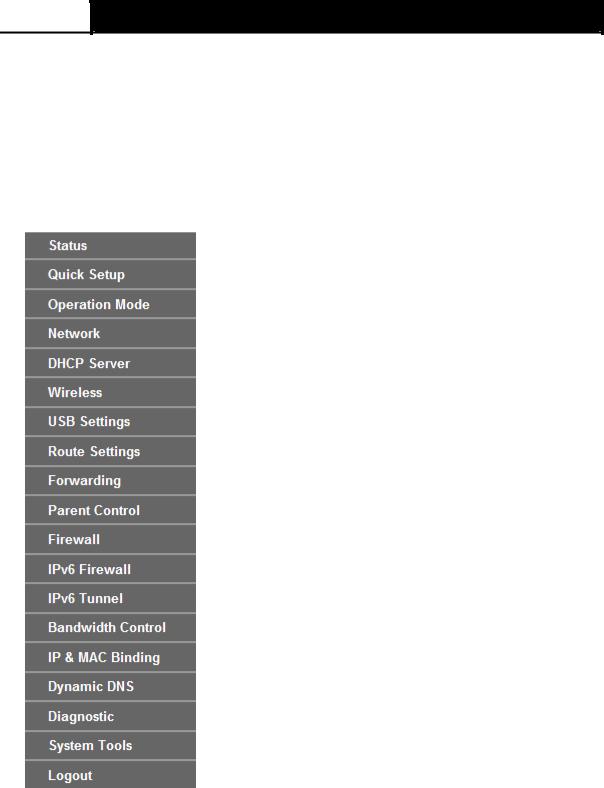
TD-W8970B 300Mbps Wireless N Gigabit ADSL2+ Modem Router (Annex B) User Guide
Chapter 4. Configuring the Modem Router
This chapter will show each Web page's key function and the configuration way.
4.1 Login
After your successful login, you will see the eighteen main menus on the left of the Web-based utility. On the right, there are the corresponding explanations and instructions.
The detailed explanations for each Web page’s key function are listed below.
4.2 Status
Choose “Status”, you can see the corresponding information about Device Information, DSL,
WAN, LAN and WLAN.
16
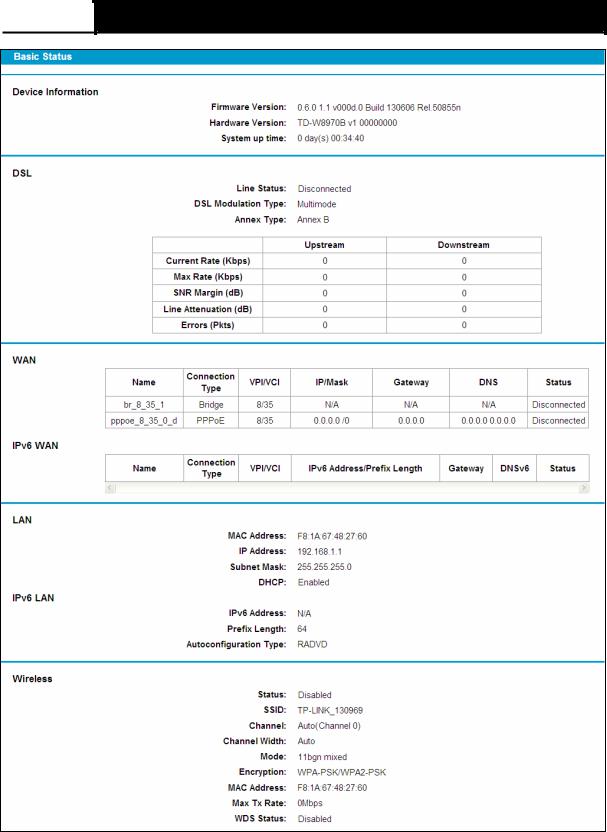
TD-W8970B 300Mbps Wireless N Gigabit ADSL2+ Modem Router (Annex B) User Guide
Figure 4-1
4.3 Quick Setup
Please refer to Section 3.2 Quick Installation Guide.
17
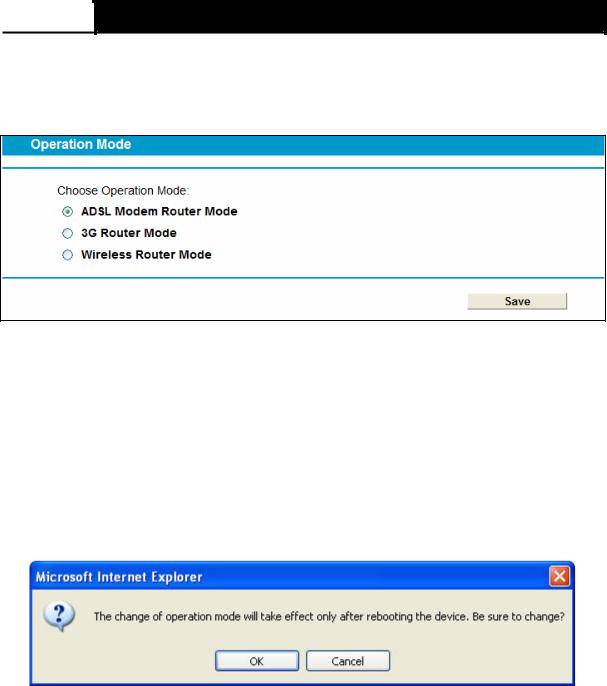
TD-W8970B 300Mbps Wireless N Gigabit ADSL2+ Modem Router (Annex B) User Guide
4.4 Operation Mode
Choose “Operation Mode”, and you will see the screen as shown in Figure 4-2. Select your desired mode and then click Save.
Figure 4-2
¾ADSL Modem Router Mode: In this mode, the device enables multi-users to share Internet via ADSL using its ADSL port and share it wirelessly at 300Mbps wireless 802.11n speeds.
¾3G Router Mode: In this mode, the device allows multi-users to share a 3G mobile broadband connection via wired or wireless connection.
¾Wireless Router Mode: In this mode, the device enables multi-users to share Internet via Ethernet WAN (EWAN) using its interchangeable LAN/WAN port and share it wirelessly at 300Mbps wireless 802.11n speeds.
After you click the Save button, the Note Dialog will appear. Click OK and then the modem router will reboot. Please wait.
Note Dialog
4.5 Network
Choose “Network”, there are many submenus under the main menu. Click any one of them, and you will be able to configure the corresponding function.
18
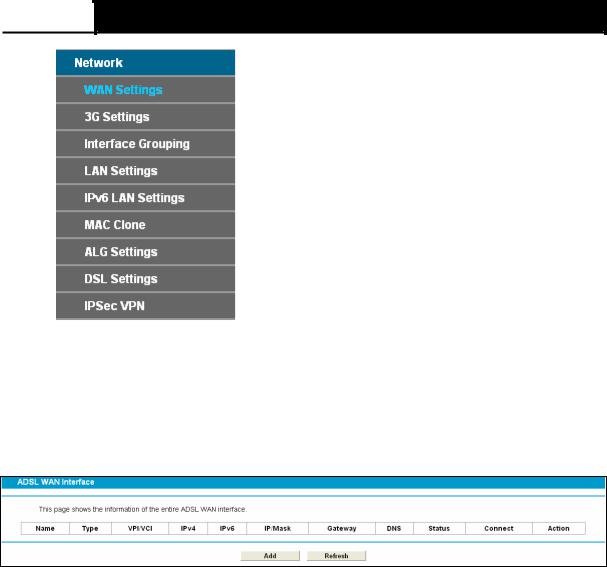
TD-W8970B 300Mbps Wireless N Gigabit ADSL2+ Modem Router (Annex B) User Guide
4.5.1 WAN Settings
Choose “Network”Æ“WAN Settings”, and you will see the WAN Port Information Table in the screen similar to Figure 4-3, which describes the WAN port settings and the relevant manipulation to each interface. There are five different configurations for the connection types, which are Static IP, Dynamic IP, PPPoE, PPPoA, IPoA and Bridge. You can select the corresponding types according to your needs.
Figure 4-3
Click Add to add a new entry, you can configure the parameters for ATM and WAN Service in the next screen (shown in Figure 4-4).
19

TD-W8970B 300Mbps Wireless N Gigabit ADSL2+ Modem Router (Annex B) User Guide
Figure 4-4
4.5.1.1 Static IP
Select this option if your ISP provides static IP information to you. You should set static IP address, IP subnet mask, and gateway address in the screen below.
20
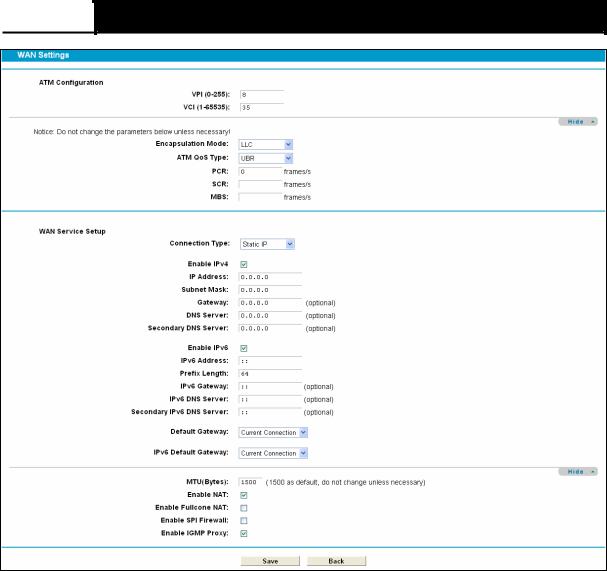
TD-W8970B 300Mbps Wireless N Gigabit ADSL2+ Modem Router (Annex B) User Guide
Figure 4-5
ATM Configuration:
¾VPI (0~255): Identifies the virtual path between endpoints in an ATM network. The valid range is from 0 to 255. Please input the value provided by your ISP.
¾VCI (1~65535): Identifies the virtual channel endpoints in an ATM network. The valid range is from 1 to 65535 (1 to 31 is reserved for well-known protocols). Please input the value provided by your ISP.
Click Advance, advanced selections of ATM Configuration can be shown.
¾Encapsulation Mode: Select the encapsulation mode for the Static IP Address. Here you can leave it default.
¾ATM Qos Type: Select ATM Qos Type provided by ISP, and the type is UBR by default. WAN Service Setup:
¾Enable IPv4 Check the box to enable IPv4.
¾IP Address: Enter the IP address in dotted-decimal notation provided by your ISP.
¾Subnet Mask: Enter the subnet Mask in dotted-decimal notation provided by your ISP, usually is 255.255.255.0.
¾Default Gateway (Optional): Enter the gateway IP address in dotted-decimal notation provided by your ISP.
21
